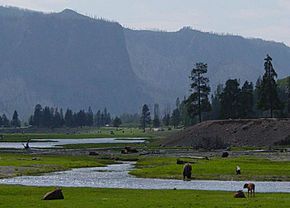Gibbon River facts for kids
Quick facts for kids Gibbon River |
|
|---|---|

Bison grazing near the Gibbon River in Yellowstone National Park
|
|
| Country | United States |
| State | Wyoming |
| County | Teton County |
| Region | Yellowstone National Park |
| Physical characteristics | |
| Main source | 6,795 feet (2,071 m) 44°45′10″N 110°33′57″W / 44.75278°N 110.56583°W |
| River mouth | 44°38′32″N 110°51′56″W / 44.64222°N 110.86556°W |
| Length | ~25 miles (40 km) |
| Basin features | |
| River system | Missouri River |
| Basin size | 126 square miles (330 km2) |
The Gibbon River is a beautiful river in Yellowstone National Park. It flows through northwestern Wyoming in the United States. This river is on the east side of the Continental Divide. The Gibbon River joins with the Firehole River. Together, they form the Madison River. The Madison River then flows into the much larger Missouri River.
Contents
The Gibbon River's Journey
The Gibbon River starts its journey at Grebe Lake. This lake is right in the middle of Yellowstone National Park. From Grebe Lake, the river flows a short distance into Wolf Lake.
Waterfalls and Geysers
After Wolf Lake, the river goes through Virginia Cascades. These are pretty waterfalls! Then it flows into the Norris valley. The river passes close to the Norris Geyser Basin. This area has many hot springs and geysers. It also flows through the Gibbon Geyser Basin.
River's End and Naming
From the geyser basins, the Gibbon River travels through the Gibbon River Canyon. It then meets the Firehole River. When these two rivers meet, they form the Madison River. Long ago, maps called this river "Gibbons Fork." Sometimes it was called the "East Fork of the Madison River." A main park road, the Grand Loop Road, runs next to the river. The river and its famous Gibbon Falls are named after Colonel John Gibbon. He was a U.S. Army officer. He helped explore Yellowstone in 1872.
Fishing in the Gibbon River
The Gibbon River is a very popular spot for trout fishing. It is known for its clear waters and beautiful surroundings.
Upper River Fishing
The upper part of the river is hard to reach. It has thick forests and many fallen trees. The fish here are usually small. You might catch brook trout, rainbow trout, or grayling. These fish are often less than 10 inches (250 mm) long.
Lower River Fishing
Below Gibbon Falls, it is much easier to get to the river. This part of the river has many rainbow and brown trout. In the fall, many brown trout swim upstream to lay their eggs. This is called a "spawning run."
Fishing Rules
If you fish below Gibbon Falls, you must use fly fishing gear only. Also, all fish you catch must be released back into the water. This is called "catch and release." Above the falls, you must release any grayling or cutthroat trout you catch. But you can keep as many brook, rainbow, or brown trout as you like from the waters above the falls.
Images for kids
-
Gibbon River bridge near Beryl Spring, 1912








